10 Things That Are Amazing About Risso’s Dolphins
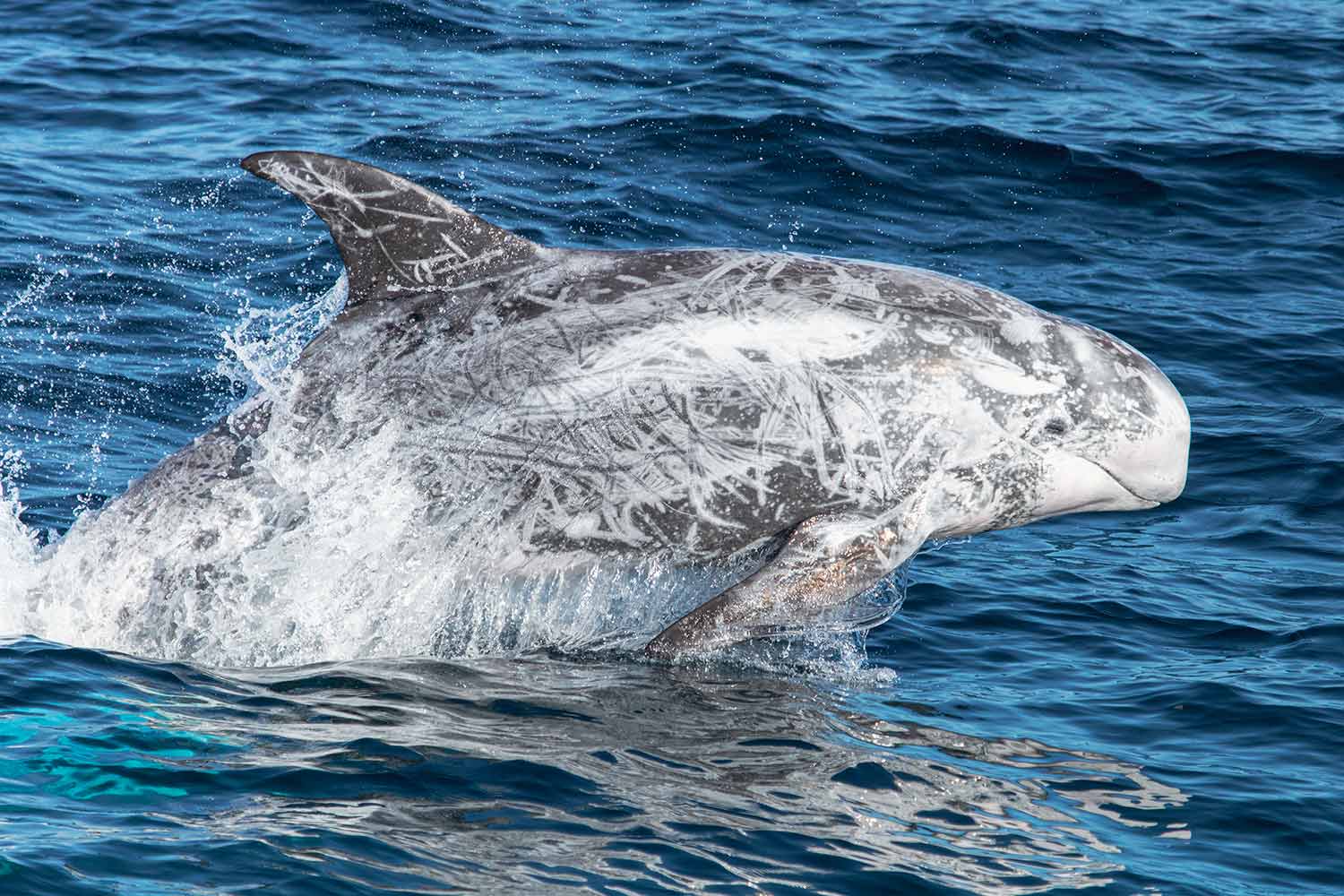
Odontocetes make up a vast group of dolphins, whales, and porpoises with one common characteristic; they all have teeth instead of baleen. Seventy-three different species of toothed whales make up this category. Grampus griseus, commonly known as Risso’s dolphins, maybe the most unique. Keep reading below to find out ten amazing facts about dolphins that are unlike any other dolphin!
1. Risso’s Dolphins Are the Only Species of the Genus Grampus
That’s true; there are 73 species of porpoise and dolphins, and other toothed whales but only one species within the genus of Grampus. Scientifically known as Grampus griesus, these stunning dolphins are named after Antoine Risso (pronounced ree-so), who first publicly documented these animals. Risso’s dolphins belong to the dolphin family known as Delphinidae, whose members include common dolphins, pacific white-sided dolphins, and bottlenose dolphins. The unique attributes of this group of dolphins place them into the sub-family of “blackfish” by many researchers and whale enthusiasts.
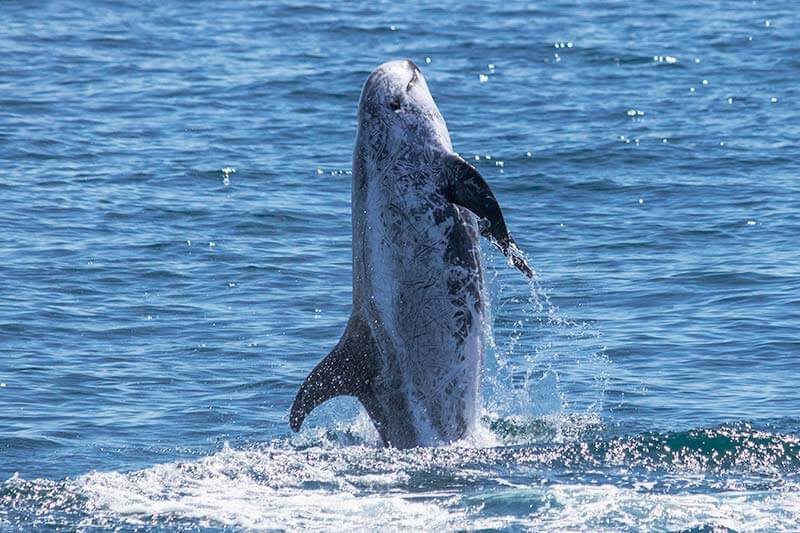
2. Risso’s Dolphins are Unique
Like many dolphins, Risso’s dolphins are born gray. Over time, Risso’s dolphins become scared from feasting on their favorite squid meal, and their coloring changes dramatically. When attacked, squid put up a ferocious fight, leaving Risso’s dolphins with unique white markings all over their body. These markings help them stand out from their fellow dolphin friends underwater. Risso’s dolphin’s coloring is unlike any other dolphin in the ocean. Typically a shy dolphin who prefers to keep their distance from the boat’s bow, their one-of-a-kind markings make them a sight to see out in the deep blue! When spotting these animals from above the surface, you can see their white skin illuminating underwater.
One rare Risso’s dolphin who visits the temperate waters on Dana Point, CA, is “Blanco.” This Risso’s dolphin has a form of leucism, which gives this individual its completely white coloring outlined with thin black piping along with the head, pectoral fins, and fluke. Check out this dolphin’s dramatic coloring below:
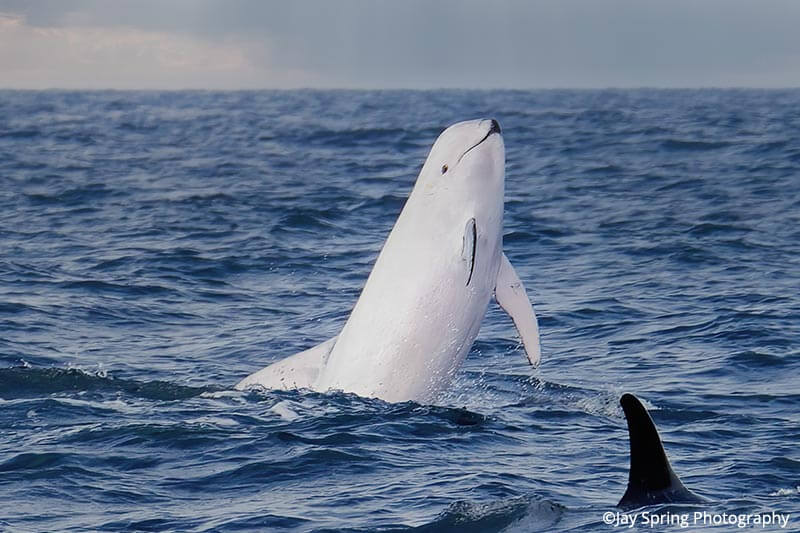
3. Risso’s Dolphins are Large Oceanic Dolphins
Risso’s dolphins range in pod sizes from solitary animals to just a few individuals to several hundred. Everyone at Capt. Dave’s Dolphin Safari becomes electrified when Dana Point whale watching boats catch a glimpse of Risso’s dolphins in the water. These dolphins are considered the 5th largest dolphin species, with an average length and weight between 11-13 feet and 660 – 1,200 lbs., respectively. When seen up close, these larger oceanic dolphins are just under one-half the size of some of our boats! Always bring your camera on your next Capt. Dave’s Dolphin and Whale Watching Safari, because seeing Risso’s dolphins are dolphins; you will want to show off to your friends and family.
4. Risso’s Dolphins Have the Fewest Teeth of All the Toothed Whales
Risso’s dolphins have the fewest teeth out of the five different dolphins in Dana Point, CA. Unlike the long beak common dolphin, which wins the award for having the most teeth, Risso’s dolphin’s teeth are few, blunt, and rounded out. Many of our passengers are surprised to learn that Risso’s dolphins only have 4 and 14 teeth in their lower jaw. These beautiful dolphins secure the top spot with the least amount of teeth inside those gnawing and gnashing jaws.
5. Risso’s Dolphins Do Not Have a Pronounced Rostrum (Beak)
Unlike the Tursiops, the Grampus griseus dolphins do not have a long pointed rostrum or beak. Their blunt, bulbous head shape mirrors that of their more closely related relatives, the pilot whale, pygmy killer whale, melon-headed whale, and false killer whale. Like all toothed whale cetaceans, Risso’s dolphins possess a mass of fatty tissue (or adipose) used in communication and echolocation. This concentrated mass creates a distinct vertical crease along the upper surface of the exterior of their melon, accentuating their blunt, bulbous head.
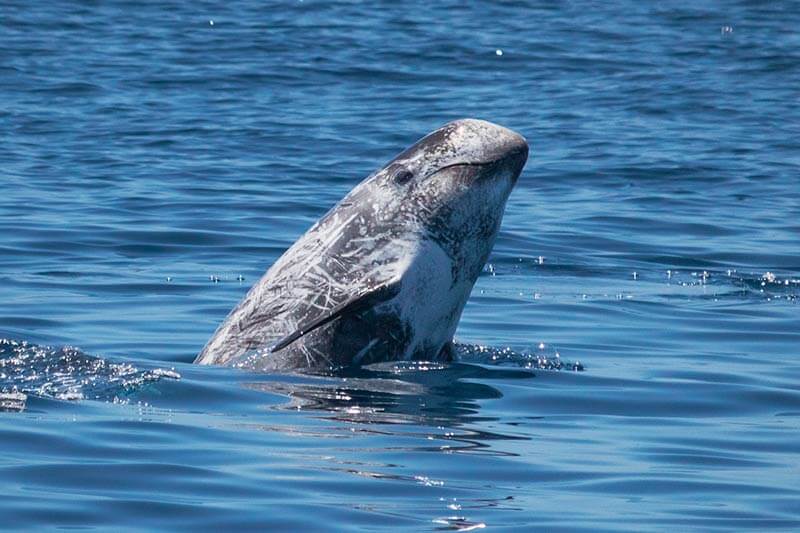
6. Risso’s Dolphins Porpoise Out of the Water!
Risso’s dolphins are boat-shy marine mammals, but within their pod groups, they are highly social. Passengers often have the chance to see them leaping out of the water, breaching, tail slapping, and generally having a hectic time at the surface. When displaying these remarkable behavioral traits, this species is gregarious and is often seen ‘porpoising’ at the water surface. These dolphins interact with other species, including bottlenose and pacific white-sided dolphins. Some pod groups have also mated with these species, and hybrid species have been created!

7. Risso’s Dolphins Are Primarily Deep-water Dwellers
Risso’s dolphins eat a variety of ocean options ranging from krill, small fish, and other crustaceans. They love to feast on their favorite meal of cephalopods (squid, cuttlefish, octopus, and nautilus). Typically cephalopods are located at the base of the seaward side of underwater mountainous terrains. In Dana Point, CA, Whale Watching Capital Of The World®, our vast, rugged underwater topography creates areas for high marine activity and enhanced fishing opportunities for Risso’s dolphins, where their favorite feast of squid prefer to dwell. These dolphins are believed to take advantage of feasting at night when prey is most likely to rise closer to the ocean’s surface.
8. Global Estimates of Risso’s Dolphins Do Not Exist
Rough estimates show that there are approximately 60,000 Risso’s dolphins around the continental shelf of the United States. In the Pacific Ocean, a census recorded 175,000 individuals in eastern tropical waters and populations of over 85,000 in the west.* Dana Point is home to Risso’s dolphins all year long, and passengers can see these beauties on any trip throughout the day, every day of the week. No matter what day you choose to visit, any day could be a day you could see one of Risso’s dolphins in Dana Point, Whale Watching Capital Of The World®.
9. Risso’s Dolphins Interact With Other Species of Dolphin
Risso’s dolphins are commonly seen with oceanic bottlenose and Pacific white-sided dolphins. Risso’s have been documented mating with other bottlenose dolphins creating hybrid species! Passengers aboard our Capt. Dave’s Dolphin and Whale Watching Safari have the chance to witness these new emerging species sightings.
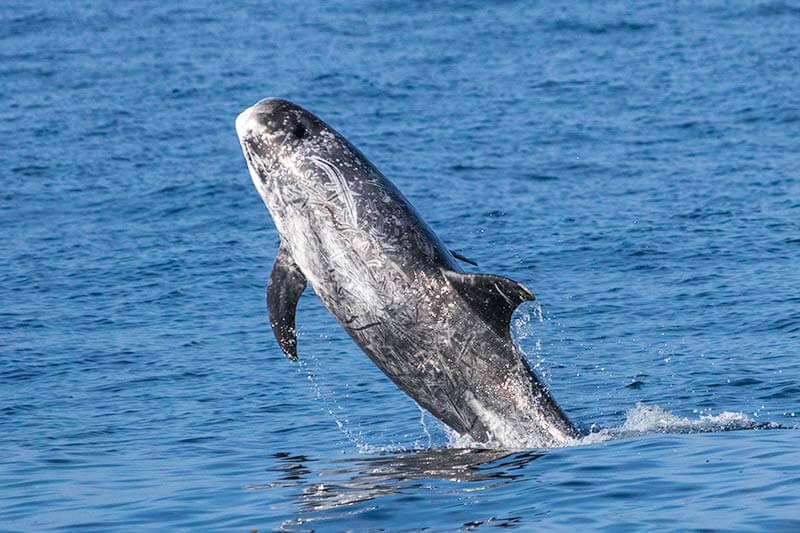
10. Risso’s Dolphin Calves Are Born Gray
Like many youngsters in the family Delphinidae, newborn Risso’s dolphin calves can have a grey to brown back with a creamy-white abdomen. With time and maturity, young Risso’s dolphins will lighten in color, and only the dorsal fin will remain dark. Their white coloring is believed to result in a lack of pigmentation and damaged tissue and a slower healing process than other dolphin species. Linear scarring occurs from a young age due to regular dolphin-to-dolphin interaction, feeding, prey, and parasites. Over time, it will scar the animal until it reaches an older age and can appear almost entirely white.
Sadly, these gorgeous oceanic dolphin beauties are threatened by the apex predators on land, humans. Risso’s dolphin meat is used for fertilizer in some parts of the world. Since these dolphins are regarded as brilliant animals, large-scale marine animal aquatic parks find them attractive and take Risso’s dolphins from wild pods and place them inside marine mammal tanks to perform shows for the paying public. Underwater noise is also considered a threat as these animals hunt at great depths to forage for food. Spending time learning about how you can help protect these animals will allow them to continue to be seen in the world.
We look forward to taking you and your guests out on an adventure of a lifetime, providing you an opportunity to see these fantastic animals up-close in their wild and free natural habitat.
Until then,
Jess Wright
First Mate and Marine Naturalist
Capt. Dave’s Dolphin & Whale Watching Safari
